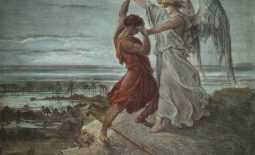The Staff of Moses
Note: jLab is for blog posts about creative, fun, or interesting Jewish or congregation-related topics. To submit a post, you must be a member of our congregation, and the topic must be Jew-ish, related to our congregation or the wider Jewish community. If you have something to share, please submit it here. The views and ideas expressed are those of the author and not necessarily representative of the views of Agudas Achim.
The Staff of Moses
A recycled dvar Torah for Parshat Chukat
Douglas W. Jones
July 8, 2022
Reading over this week’s parsha, there are so many good things to talk about. I wonder, for example, is the “water of lustration” produced from the ashes of the red heifer the oldest soap recipe known to humankind? That’s a chemistry lesson in itself. If you burn a red heifer, the fat will dribble down into the ashes. Ashes in water create an alkaline solution. Add fat, and you get a soap solution. It would indeed be a good idea, after contact with the dead, to wash with soap, and that is what the Bible instructs us to do.
And, was it really just for God to deny Moses entry into the promised land because he struck the rock to get water instead of merely commanding it? That seems, at the least, disproportionate.
Moses struck the rock with his staff, and with all the bad news we’ve had these last few weeks, though a bit of pure escapism was called for, so I’ll speak about the staff of Moses. Much of what I have to say here is recycled from a dvar Torah I gave back on Tu B’Shevat in 2010.
Where did Moses’ staff come from, where did it go, and where is it today? These are fun questions. I’ll start by confining myself to the Torah before I escape into the wilder world of midrash, legend and speculation. When we first learn about the staff in Shemot, Exodus 4:2, it’s not very magical. God asks Moses, “what’s that in your hand,” and Moses says “a staff”. He already had it, and nothing here suggests that Moses thinks it’s anything special. Moses was worried about how to convince Pharaoh to let his people go, and God demonstrates the trick he will use by changing Moses’ staff into a snake, without warning and much to Moses’ shock.
The next staff story is in Va Era, Exodus 7:10. Now, confronting Pharaoh, Aaron throws down his staff, it turns into a snake, Pharaoh’s magicians do the same with their staffs, and then Aaron’s snake eats the others before reverting to a staff.
Sounds like what Shemot prepared us for, but did Aaron use Moses’ staff, or did he have his own?
The first 3 plagues, blood, frogs and lice, are all initiated by Aaron using his staff. Plagues 4, 5 and 6, however seem to be done without a staff. There is a little ambiguity in the first plague. God tells Moses to Tell Aaron to lift his rod and strike the Nile, but then, when it actually describes the deed, it says that they did as instructed, and then it says he struck the Nile with the rod, not his rod. Then, a few verses later, it refers to God as having stuck the Nile.
Moses uses his staff Exodus 9:22 to initiate plague 7, hail. Here, God commands Moses to hold out his arm, but Moses uses his staff. Plague 8, Locusts works the same way. I didn’t notice the staff being used in plague 9, darkness. There, it seems, it suffices for Moses to merely hold out his arm.
The story is similar for the parting of the sea. In parshat Beshalach, Exodus 14:21, Moses lifts up his rod and holds out his hand and the waters recede. I wonder, for plague 9 was Moses holding his staff in that upraised hand? The text doesn’t say.
And then, with the story of the stone at Rephedim, we begin to get some answers: In Exodus 17:6, Moses is told to strike the rock with his staff, the same one with which he struck the Nile. Ah, but if this is a reference to the plague of blood, didn’t Aaron do that! This looks like someone, was it the editor of the J text or the P text, forgot to do a good job of proofreading.
The staff shows up one more time in Exodus, also in Beshalach. In Exodus 17:8, Amelek attacks, and the outcome of the battle is determined by how Moses holds the staff. Here, the staff gets promoted. When we first encountered the staff, it was just the staff Moses happened to have in his hand. Then, it was Moses’ staff and perhaps Aaron’s. Now, it is described as “the staff of God.” When Moses raises it, the Israelites win, while if he lowers it, they lose. Even with the help of the staff, it’s a long battle, and Moses needs help keeping it upraised.
The staff takes a break right where I’d have wanted to use one. If Moses used the staff to climb Mount Sinai, I didn’t notice it. In my imagination, Moses surely has his staff when he’s up on the mountain, but I don’t see it in the text.
The staff shows up again many pages later, in parshat Korach, Numbers 17:16. Aaron’s leadership has been challenged. The leaders of the 12 tribes are each told to bring their staffs, and Aaron’s leadership is proven by the fact that his staff sprouts leaves, flowers and bears fruit overnight. Not just fruit, but almonds. The natural conclusion is that Aaron’s staff was made of almond wood.
This episode ends with the commandment to keep the staff with the ark of the covenant for all time. The collection of keepsakes that go with the ark also includes the Torah scroll itself and a jar of Manna. This suggests that the fate of the staff is the same as the fate of ark itself, probably carried off with the loot when the first Temple was destroyed.
In today’s parsha, Chukat, Numbers 20:17, we reach the end of the staff story. Moses is told to take
the staff and command the cliff to give water. He doesn’t merely command, he strikes the rock. It would seem that this is exactly what he did at Rephedim. If it is a sin to use the staff when not told to do so, then it would seem that the way Moses acted to bring about plagues 7 and 8, hail and locusts, was similar. There, he was told to use his hand but he used the staff.
The text says “take the staff” not “take your staff” or “take Aaron’s staff”. That suggests that there might be only one staff, but then, why earlier in the text were there such explicit statements about Aaron’s staff for plagues 1, 2 and 3 and Moses’ staff for plague 7?
There’s one mysterious mention of staffs later, in Numbers 21:18. The people are so happy about a well that they sing, and the song says that the well was “carved out with their staffs”. Whose staffs? Was Moses’ staff among them? Finally, in Parsha HaAzinu, Deuteronomy 32:51, we learn that Moses will die before entering the promised land because he dishonored God back in Chukat.
I have a staff, but mine doesn’t do any of the neat things Moses’ staff does. When I strike rocks with my staff, all I get is a thump. No water, rivers don’t turn to blood, and mine hasn’t sprouted one single leaf since I cut it from the tree.
The lowly staff Moses just happened to be holding in his hand when we first encounter it didn’t seem any more distinguished than mine, but as the story progresses, we learn that it isn’t just a stick, it is the Staff of God and becomes one of the select object retained with the Ark of the Covenant. Moses’ staff gains further stature in the land of Midrash.
In Pirke Avot 5, there is a wonderful list of things that were created on the first erev Shabbat. The mouth of the earth that swallowed Korach, the voice of Baalam’s ass, the rainbow, and some say that tongs are among them. The list includes all the agencies of supernatural events in the Exodus story. Moses’ staff is in that list. The Zohar says God gave the staff directly to Moses, but Rabbi Eliezer told a more interesting story (according to Pirkei de Rabbi Eliezer 40):
Created at twilight, before the Sabbath, it was given to Adam in the Garden of Eden. Adam gave it to Enoch, who gave it to Methuselah; he in turn passed it on to Noah. Noah bequeathed it to his son Shem, who transmitted it to Abraham. From Abraham to Isaac, and then to Jacob, who took it with him to Egypt. Jacob gave it to Joseph; upon Joseph’s death all his possessions were removed to Pharaoh’s place. Jethro one of Pharaoh’s advisers desired it, whereupon he took it and stuck it in the ground in his garden in Midian. From then on no one could pull out the staff until Moses came. He read the Hebrew on the staff, and pulled it out readily. Knowing then that Moses was the redeemer of Israel, Jethro gave him his daughter Zepporah in marriage.
Shades of King Arthur pulling Excalibur out of the rock, but this story also parallels the Greek myth of the scepter of Agamemnon.
The question of whether Aaron and Moses used the same staff is an interesting one. Some of the midrash say they are the same, but others say no. I found one that says that when Moses struck the rock in Chukat, he was using the wrong staff – he’d taken Aaron’s staff when he was supposed to use his own.
Others note that Aaron’s staff does some dirty work like eating snakes. The staff of God, the one held by Moses, could not be allowed to eat snakes or touch water that was turning to blood.
But, this staff, made of either almond wood or sapphire, was cut by God from the Tree of Life in the Garden of Eden and inscribed with the Tetragrammaton, the holy four-letter name of God, and possibly also with the names of the ten plagues.
You could take the staff to be some kind of magic wand. Compare it, for example, to Dumbledore’s wand in Harry Potter — the fabled (if J. K. Rawlings is to be believed) death stick. That wand does the bidding of any wizard who wins it from its previous owner in a wizarding duel.
In contrast, the staff of Moses can only be used to perform miracles at God’s command. I suspect that it served as a walking stick at other times, but the final time Moses used it contrary to God’s command, the punishment was death.
So where is the staff today? Rabbi Posner, writing on Chabad On Line, says that the Midrash tells us that the staff was passed down from generation to generation and was in the possession of the Judean kings until the First Temple was destroyed. In Samuel I, 17:40, we are told that King David “took his staff in his hand.” According to Midrashic tradition, this is a reference to Moses’ special staff.
It is unknown what became of the staff after the Temple was destroyed and the Jews were exiled from their land, but today, two museums have staffs that have been described as Moses staff:
Topkapi Palace, in Istanbul, has one claim. The Privy Chamber in the third courtyard of the palace contains the most sacred relics in the Muslim world. Among them are Mohamed’s cloak, the turban of Joseph, and the staff of Moses.
I’ve never been there, so I can’t offer any testimony as to the truth of this claim, but the treasures are on public display. However, there is a second claimant: The Birmingham Museum in England has the staff of Tuthmosis. Not only is the name Tuthmosis similar to Moses, but his career, to the extent it is documented, has parallels. He was involved in something of a slave rebellion and exodus, moving in the process from the court of the Pharaoh to exile in the east. The staff was recovered from a tomb in Jordan. The British writer Graham Phillips asserts with great certainty that this is the staff of Moses.
For myself, I don’t think I’ll go off looking for the staff of Moses. I find my own stick sufficient for my needs, but researching Moses’ staff has been great fun.
Let’s return to that question I posed earlier: Why was it wrong for Moses to use the staff that final time? Remember, the abuse he performed in his final use of the staff was not that different from what he did for plagues 7 and 8. I have a theory about this, and it relates to my mention of J. K. Rawlings’ Death Stick, as well as to the magic wands of Pharaoh’s advisors that were eaten by Aaron’s staff — as a snake.
We’re not supposed to be into magic. Pharaoh believed in magic, so it was OK for Moses to act magical as he “worked miracles” with his staff. On the way out of Egypt, the Israelites were still, culturally, thinking like Egyptians, as emphasized by the story of the golden calf. So, early in the exodus story, it makes sense for Moses to use the staff as a magic wand.
Later, though, after the Israelites have been cleansed of their beliefs in magic and after they’ve witnessed unmistakable evidence of God’s direct intervention in the world, they no longer need to see Moses wave a magic wand. In fact, he should not do so. It’s one thing to act like a wizard before Pharaoh, but another to act like a wizard before the Israelites after they’ve begun to mature. The risks are that Moses could set himself up as more than a prophet — being seen as a wizard, and that the staff could be seen as having magic power inherent in itself, becoming, as it were, an idol.
I, for one, am much more comfortable with the idea that Moses staff was nothing but a piece of wood that happened to be in his hand when God first inquired about it, and that it’s only value is as a relic, a reminder of the exodus, with no inherent magic to it. But, many of the authors of our midrash took a different tack that may accomplish the same goal. They made the staff one of a kind, created on the eve of the first Sabbath. There is and will be no other staff like it. Yes, that staff had miraculous properties, but abusing it was fatal, and besides, it was lost long ago. In sum, any staff you may find today is just a tree branch, like mine.




